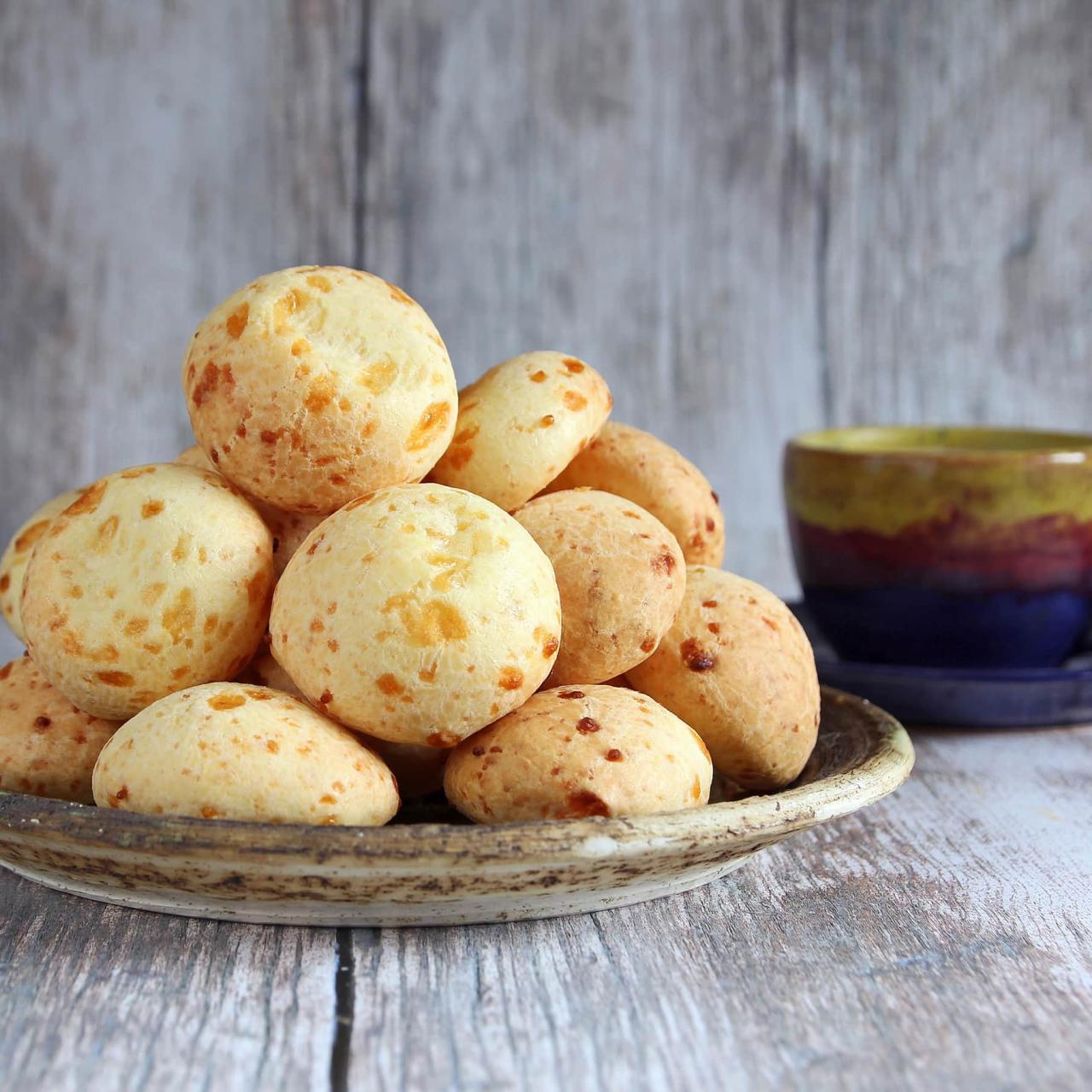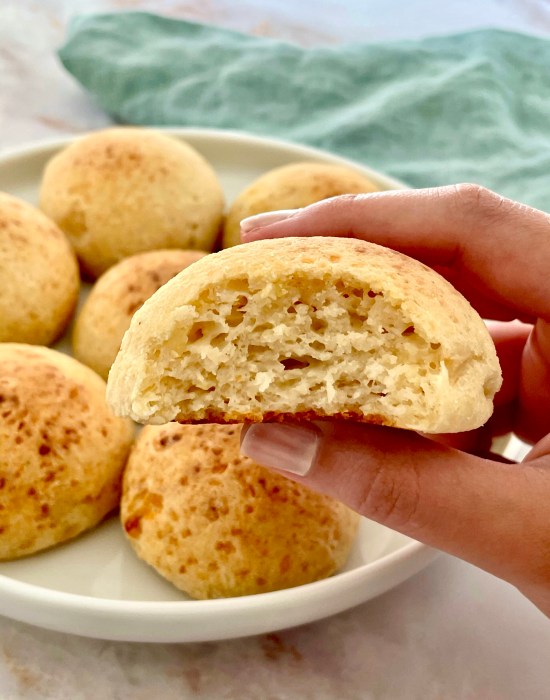Pandebono, the beloved Colombian cheese bun, is a culinary gem that captures the essence of comfort in every golden, crusty round. These warm, cheesy delights are more than just a treat; they’re a celebration of tradition and the joy of sharing. On mornings when the kitchen is awash with sunlight, or during afternoons when the house feels too quiet, the act of kneading dough becomes a grounding ritual, a connection to a culture rich with flavor and warmth.
In my own experience, pandebono is the answer to a craving for something hearty yet simple, a snack that pairs perfectly with a cup of strong coffee or hot chocolate. The allure of its crisp exterior giving way to a soft, chewy center, where the tang of the cheese meets the subtle sweetness of the dough, is irresistible. Whether it’s to honor my heritage or to introduce friends to the delights of Colombian baking, making pandebono is an act of love—a small, savory celebration of the everyday moments that bring us together. Join me as we explore the steps to creating these delightful cheese buns, each one a bite-sized invitation to savor life’s simple pleasures.
Pandebono Cheese Bun Recipe

Pandebono, also known as Pan de Bono, is a traditional Colombian cheese bread that’s cherished for its unique texture and flavor. It’s made from a mixture of cassava starch (tapioca flour), cornmeal, cheese, eggs, and sometimes a leavening agent. The dough is shaped into small buns or rings and then baked until they’re golden and puffed up. The result is a warm, soft, and chewy interior with a slightly crisp exterior, characterized by the savory taste of the cheese used, which is typically queso fresco or a similar white cheese. Pandebono is often enjoyed fresh out of the oven, served as a snack, breakfast item, or accompaniment to meals, particularly with a cup of coffee. Its popularity extends beyond Colombia, with variations found in other Latin American cuisines and among communities abroad.

Pandebono Cheese Bun
Equipment
- 1 oven
Ingredients
- 2 cups cotija cheese or feta cheese
- 2 cups cassava flour
- 3 Tablespoons cornmeal or Mexican flour tortilla.
- 2 Teaspoons sugar.
- 2 eggs
- 1 Tablespoon baking powder
- ⅓ Cup of warm milk.
- Salt to taste add very little as some of these cheeses are already salty.
Instructions
- PREHEAT oven to 350 degrees temperature.
- GRATE cheese in a food processor
- BEAT the eggs in a cup.
- PLACE cassava starch, corn flour, sugar, baking powder, cheese and eggs in a bowl.
- MIX all ingredients until all are well incorporated.
- ADD milk gradually and start kneading until smooth. You want the dough to be firm but not to watery.
- GREASE either a cookie tray with spray oil so the Pandebono will not stick to the cookie tray.
- GREASE the palms of your hands so the dough does not stick to them while you form the round buns.
- USE a small biscuit cutter so all the buns are the same size.
- PLACE each bun on the cooking tray separate by a distance of about 1 inch.
- PLACE tray in the middle of the oven for about 15 minutes.
- When the bread is golden on the bottom, not the top, move the tray to the upper rack and lower the temperature at 250 degrees.
- TIPS
- If the dough is to dry, you can add 2 or 3 tablespoons of milk.
- If dough is too wet, you can add 1 tablespoon of flour.
Video
How to cook Pandebono Cheese Bun air fryer

Embracing the air fryer to craft Pandebono cheese buns is a delightful nod to tradition meeting innovation. The air fryer’s embrace ensures each bun emerges with a crisp exterior while preserving the soft, cheesy heart that is the soul of Pandebono. As they cook, the kitchen fills with an aroma that speaks of Colombian streets and warm smiles. It’s a dance of convenience and heritage, where each golden bun is a small celebration of culture that can be enjoyed in mere minutes. Serving these airy delights fresh from the basket, perhaps alongside a steaming mug of coffee, is to share a piece of Colombia’s culinary magic, a gesture that says, “Here, taste the warmth of home.”
Tips for making Pandebono Cheese Bun

Cooking Tips
Crafting Pandebono cheese buns is a joyful ode to Colombian tradition, each bun a small token of cultural pride. Begin with high-quality cassava starch for that signature chewy texture, and use a good, salty cheese to infuse the dough with flavor. Knead gently, as if coaxing the ingredients to unite into a smooth harmony. Shape with love, knowing that each round or crescent carries the promise of comfort. Bake until they bloom into golden pillows, their aroma a siren call to gather and share. Serve them warm, their steam carrying whispers of home, and watch as they bring smiles, bridging hearts with every bite. In these buns lies the simple joy of baking, a craft that turns the ordinary into a celebration of heritage.
Serving suggestion

Pandebono cheese buns, with their inviting aroma and delightful texture, are best served warm, when their cheesy heart is at its most tender. Pair them with a robust cup of coffee to echo the warmth they carry, creating a moment of true Colombian comfort. As you break open a bun, the steam rises, carrying with it the promise of a savory, satisfying bite. These buns are not just food; they’re a gesture of hospitality, a way to welcome friends and family into your home. Offer them as part of a cozy breakfast spread or as an afternoon pick-me-up, and watch as they become a conversation piece, a shared experience that’s as much about the joy of eating as it is about the act of coming together.
Top 5 FAQs about Pandebono Cheese Bun
- What type of cheese is used in Pandebono? The traditional cheese for Pandebono is queso fresco or a similar fresh, white cheese like farmer’s cheese. Colombian costeño cheese or a mix of feta and mozzarella can also be used to achieve the desired flavor and texture.
- Can Pandebono be made without cassava starch? Cassava starch, also known as tapioca flour, is essential for the authentic texture of Pandebono. However, some recipes may offer substitutions with pre-cooked cornmeal or other gluten-free flours, though this will alter the final product.
- How do you achieve the perfect texture for Pandebono? The key to the perfect Pandebono texture is in the balance of ingredients and not overworking the dough. The dough should be mixed until just combined and then shaped gently to retain airiness and ensure a soft, chewy interior after baking.
- Can Pandebono buns be stored for later consumption? Pandebono is best enjoyed fresh out of the oven, but they can be stored in an airtight container at room temperature for a day or two. For longer storage, freeze them and reheat in an oven or air fryer to restore their warmth and texture.
- Are there any common variations of Pandebono? Variations of Pandebono might include the addition of guava paste for a sweet contrast, incorporating different cheeses for a unique flavor profile, or adding herbs for an aromatic twist. Some recipes also adjust the ratio of cassava starch to cornmeal for textural differences.
Pandebono cheese buns stand as a testament to the rich culinary heritage of Colombia, a simple yet profound expression of its culture. These delightful rounds of cheesy goodness are more than just a staple; they are a symbol of warmth and hospitality, an invitation to gather and savor the moment. The act of baking pandebono is a dance between tradition and personal touch, where each ingredient is woven into the fabric of shared experiences and memories. Whether enjoyed as a standalone treat or as an accompaniment to a meal, pandebono brings a sense of home to any table. In their golden crust and soft, chewy center lies the essence of comfort food—a universal language that speaks directly to the heart, uniting us in the joy of eating well and with love.